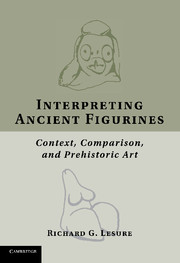Book contents
- Frontmatter
- Contents
- Figures and Tables
- Acknowledgments
- Introduction
- One Universalist Explanation and Prehistoric Figurines
- Two Comparison and Context
- Three The Questions We Ask of Images
- Four A Cross-Cultural Explanation for Female Figurines?
- Five Mesoamerican Figurines and the Contextualist Appeal to Universal Truths
- Six Figurines, Goddesses, and the Texture of Long-Term Structures in the Near East
- Seven On Figurines, Femaleness, and Comparison
- Notes
- Bibliography
- Index
Two - Comparison and Context
Published online by Cambridge University Press: 01 March 2011
- Frontmatter
- Contents
- Figures and Tables
- Acknowledgments
- Introduction
- One Universalist Explanation and Prehistoric Figurines
- Two Comparison and Context
- Three The Questions We Ask of Images
- Four A Cross-Cultural Explanation for Female Figurines?
- Five Mesoamerican Figurines and the Contextualist Appeal to Universal Truths
- Six Figurines, Goddesses, and the Texture of Long-Term Structures in the Near East
- Seven On Figurines, Femaleness, and Comparison
- Notes
- Bibliography
- Index
Summary
Figurines, we now insist, should be interpreted in context. Attention is to be directed to variation within collections and to the spatial positioning of figurines with respect to one another and to other finds. Contextual method, however, has its own larger context. Programmatic statements on the contextualization of figurines direct us to “identify the dimensions of meaning pertaining to particular societies.” Culturally specific meanings are further characterized as shifting and unstable. After all, “the meaning of figurines is likely to have been varied and varying, more ambiguous than fixed.” With contextual analyses of meanings emphasizing variety, ambiguity, instability, and contestability, one might well wonder whether there is any legitimate basis for cross-contextual comparison of prehistoric figurines. By adopting contextualism, do we restrict comparison to relatively small scales of space and time? Is universalism to be rejected altogether?
The goal of this chapter is to grapple with and move beyond such radical doubts about the comparison of figurines from different contexts. I argue that a tension – even an opposition – between contextualist and universalist approaches is real. Indeed, contextualist critiques of universalist explanation and grand history reinforce and extend the concerns about these approaches already raised in Chapter 1. Attention to context is nevertheless compatible with comparison – even comparison that is directed at subsuming multiple contexts in a common explanation. Legitimate contextualist concerns can be addressed by placing the principles of contextualization at the heart of comparative analysis. Instead of comparing figurines as isolated objects, we compare contextualizations.
- Type
- Chapter
- Information
- Interpreting Ancient FigurinesContext, Comparison, and Prehistoric Art, pp. 26 - 47Publisher: Cambridge University PressPrint publication year: 2011



